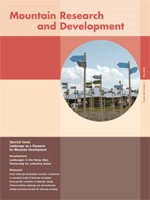Dear Readers,
There is ample evidence that landscape development, especially in areas with recreation activities and conservation interests, has recently become an issue of public concern and political action in Europe. Efforts to preserve the beauty, diversity, and productivity of landscapes are now at the top of political agendas in most Alpine countries. The Alpine Convention—Europe's common legal framework for sustainable mountain development—as well as important NGOs such as the International Commission for the Protection of the Alps (CIPRA) underpin that mountain landscapes are both a cultural heritage worthy of protection and an economic asset for mountain communities, which encourages inhabitants to remain in mountains, even in remote areas.
Landscape development seems to have reached a turning point in its history. Landscape has become a collective good as well as a contested resource. The willingness of a lowland urban society to pay for recreational space, conservation areas, as well as a place for secure living depends on mountain communities' willingness to maintain this offer. Farming and forestry activities in themselves no longer cover this demand. A more performance-related mandate is needed. In addition, climate change and society's changing needs (eg accessibility, energy) also have a considerable impact on landscape development. From this perspective, questions such as “to whom does a landscape belong,” “who decides about the future of a landscape and who pays for it?” have to be answered. In Switzerland, landscape development has become a collective task in a negotiation space; correspondingly, landscape research has expanded considerably over recent years, now including the social sciences and the humanities.
When the Swiss National Science Foundation's National Research Programme “Landscapes and Habitats of the Alps” was launched in 2002, these were the questions that guided research activities, integrating all relevant disciplines. The present special issue of MRD presents a limited number of papers but covers the main topics of the program, following the line “from knowledge to action,” as argued in an “interface” paper introducing the overall framework of the program at the beginning of the Research section.
This paper is followed by Backhaus et al, who present the many different dimensions within which landscape can be perceived and valued, with a conceptualization of landscape that justifies and legitimizes public policy in favour of landscape development. Theory-grounded and empirical investigation of different societal groups' landscape preferences is at the core of the paper by Hunziker et al (on the aesthetic, symbolic, and sensory dimensions of landscape), pointing at a major gap between mountains as a place for living and a space for recreation. The ecological and political dimensions of landscape in Switzerland are discussed by Fischer et al, who examine the interaction between culturally diverse agricultural practices and biodiversity in landscapes, followed by policy implications. Finally, Grêt-Regamey et al demonstrate the social and economic value of landscape in terms of ecosystem services.
Based on these insights, the papers in the Development section discuss what kind of action should ensue: how can management and development of landscapes take into account the different claims of landowners, inhabitants, visitors, and outdoor recreationists? Boesch et al offer the concept of “branding landscape,” ie how to give landscape economic value; Heeb and Hindenlang present their approach to negotiating landscape and reaching consensus about landscape development. Gerber and Knoepfel discuss a new way of institutionalizing landscape in Switzerland and regulating the rights of landscape uses. Johnsen et al deal with monitoring landscape and ensuring sustainable landscape management, while Walz et al present innovative ways of simulating landscape in order to support decision-making regarding landscape development.
We hope these insights from Swiss research and practice will be of interest to MRD's international audience.





